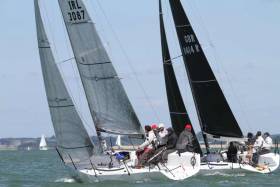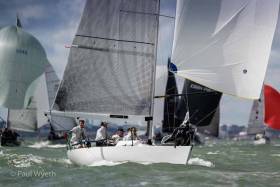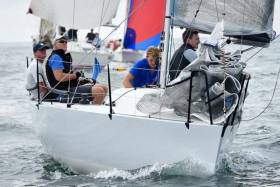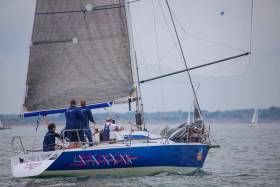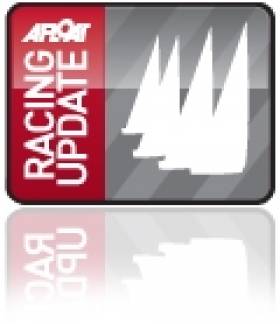Displaying items by tag: Quarter ton
Sam Laidlaw’s BLT Wins Again in Quarter Ton Class
As Royal Cork Yacht Club prepares to stage the Quarter Ton Cup in July, it's clear the form boat is Sam Laidlaw’s BLT which has been winning all around them on the Solent.
Laidlaw’s BLT won the Class for the third regatta in a row for a hat-trick of victories at the weekend's Vice Admiral’s Cup for the Cowes-based team.
Louise Morton’s all-women team racing Bullet finished the regatta with a win in race six to take runner-up, just two points behind BLT. Third was Jan Thirkettle’s Olivia Anne VI.
“We had a cracking weekend, great racing in perfect conditions, with a good ding-dong with Louse (Morton),” commented BLT’s Sam Laidlaw. “Mid-May is a great time of year as it starts to warm up a bit and the breeze is decent. The regatta was very well organised, and I hope that we will have more Quarter Tonners enjoying it next year; I think the small turn-out was due to a lot of the crew racing in the Cape 31 Class. As always, BLT is a team effort, and I can’t thank the crew enough; Brett Aarons, Tom Forrester-Coles, Ed Lynch, and Ryde School sixth-former Killian Boag on the bow.”
Royal Cork will stage the 2023 2023 Quarter Ton Cup in Cork Harbour from July 13-15th, and plans are afoot to make it 'the Quarter Ton sailing event of the decade'.
The Cup is coming to the Irish south coast from the Solent (for the first time since the Cup was resurrected 17 years ago).
The Quarter Ton Cup is awarded to the World Quarter Ton class championships winners between 1968 and 1997 and for the Quarter Ton Classic Revival from 2005 to the present. The fleet's main centre is on the Solent.
2023 Quarter Ton Cup to be Staged by Royal Cork Yacht Club in July
Royal Cork Yacht Club will stage the 2023 Quarter Ton Cup in Cork Harbour from July 13-15th, and plans are afoot to make it 'the Quarter Ton sailing event of the decade'.
News of the Cup coming to the Irish south coast from the Solent (for the first time since the Cup was resurrected 17 years ago) has been circulating for several weeks, but the event was confirmed on social media this weekend.
The Quarter Ton Cup is awarded to the winners of the World Quarter Ton class championships between 1968 and 1997 and for the Quarter Ton Classic Revival from 2005 to the present. The fleet's main centre is on the Solent.
The awarding of the event follows a resurgence in Quarter Ton's interest in Crosshaven over the past few seasons.
Several Royal Cork sailors have bought upgraded Quarter Tonners, such as Conor Phelan's Anchor Challenge. Others to arrive in Cork Harbour include Illegal, Panic and Diamond.
 Quarter Tonner Panic competing in Cork Harbour Photo: Bob Bateman
Quarter Tonner Panic competing in Cork Harbour Photo: Bob Bateman
The boats have been racing as part of a strengthening of Cork Harbour's Class Three in the 2022 season, with the arrival of three more good Quarter Tonners in the early part of the year.
The event will be held on Thursday, 13th, Friday, 14th and Saturday, 15th of July 2023, hosted by RCYC.
 Quarter Tonners GBR 6498 Diamond and Illegal IRL 1751 competing in Royal Cork Yacht Club's 2022 Autumn League in Cork Harbour. Crosshaven will host the 2023 Quarter Tom Cup from July 13. Photo: Bob Bateman
Quarter Tonners GBR 6498 Diamond and Illegal IRL 1751 competing in Royal Cork Yacht Club's 2022 Autumn League in Cork Harbour. Crosshaven will host the 2023 Quarter Tom Cup from July 13. Photo: Bob Bateman
"Come over, you lovely European quarter ton sailors and let's have a great festival of QT sailing", UK Quarter Ton promoter John Santy posted on social media.
The event could also present an opportunity for other Irish sailing events as potential Quarter Ton Cup warm-ups, such as the Sovereign's Cup in Kinsale from June 21-24 and Dun Laoghaire's Volvo Dun Laoghaire Regatta on Dublin Bay from July 6-9.
Although this Quarter Tonner has had three previous Cork owners, Anchor Challenge has spent the past few seasons in a shed in Cowes on the Isle of Wight, well away from her original moorings.
Happily now, however, the ICRA class champion yacht is back in Crosshaven under new ownership and as our photo above shows she joins a growing Cork Harbour a Quarter Ton movement at Crosshaven and Cobh.
As regular Afloat readers will know, Anchor Challenge's last Cork owner was Paul Gibbons who was good on enthusiasm, and good on performance, taking this classic Quarter Tonner to an overall win in the IRC Europeans at Crosshaven in July 2016.
Cork Harbour's Class Three continues to strengthen for the 2022 season with the arrival of several other good Quarter Tonners in the last two months as Afloat reports here
See Bob Bateman's photos below of Anchor Challenge's last season in Irish waters.




A third scored in today's race eight of the Quarter Ton Cup moves Paul Gibbons's Anchor Challenge within six points of the top five overall. The Royal Cork yacht is the top Irish boat in the 23-boat fleet, two places ahead of Royal Irish entry Quest, skippered by Barry Cunningham. The third Irish boat, Cobh Pirate has moved up two places to be 13th overall.
Download results below
The second day of the 2018 Revival Quarter Ton Cup brought gorgeous warm sunshine and extremely challenging conditions for the 21 strong fleet off Cowes. A constantly shifting and variable northerly wind ranging from 6 to 16 knots, plus a building flood tide kept both the crews and the race committee on their toes. In a single leg the boats could find themselves going from ghosting along with crew to leeward to broaching out in the gusts, whilst the race committee had to hold their nerve, yet be ready to act quickly when a shift held instead of swinging back.
 Two good races and two bad ones today has RIYC's Quest in eighth overall. It's the team's first ever Quarter Ton Cup and already counting some top five race results Photo: Fiona Brown
Two good races and two bad ones today has RIYC's Quest in eighth overall. It's the team's first ever Quarter Ton Cup and already counting some top five race results Photo: Fiona Brown
With the forecast for tomorrow’s final day of racing threatening northerly winds of sub-five knots, Race Officer Rob Lamb wisely elected to run a further four races, races five to eight of the series, leaving just a single race to complete on the final day. A decision universally applauded by the fleet.
The change of pace brought some new faces to the fore and some interesting changes to the leader board. The racing was also extremely close with many results being decided by just a couple of seconds.
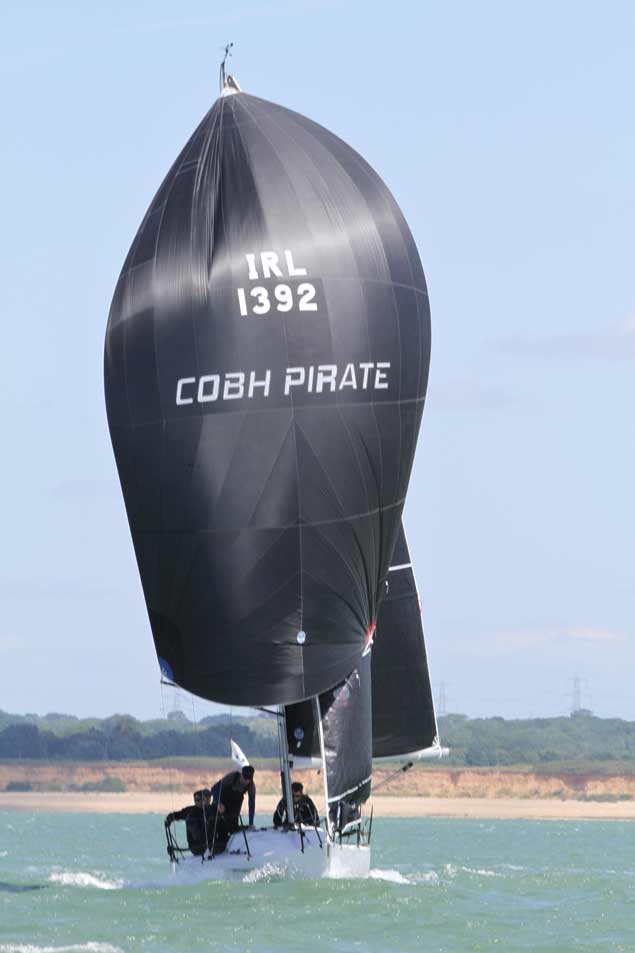 Cobh Pirate is up two places overall to 13th Photo: Fiona Brown
Cobh Pirate is up two places overall to 13th Photo: Fiona Brown
Sam Laidlaw’s Aquila and Kieran Hayward’s Black Fun revelled in the new conditions, winning two races apiece. Also enjoying the challenge was Catrina and Ian Southworth’s Whiskers, Julian Metherell’s Bullit and Barry Cunningham’s Quest, who all claimed top three finishes during the day.
One team not so happy with the lighter conditions was Louise Morton’s Bullet crew, who went into the day with a confident overall lead, but seemed to struggle to gain traction and frequently found themselves buried in the pack.
Quarter Ton Cup reigning champion Aquila was by far the best performer of the day, claiming a 2, 1, 1, 4 score line. With the series’ single discard now coming into play and a discarded worst score of fifth place in yesterday’s third race this gives Aguila an unassailable six-point lead over her nearest rival. But whilst the overall winner may already have been decided, the battle for the remaining podium positions will go down to the wire. Blackfun won the opening race of the day, but faltered with an eleventh in race six, before coming back with a second and a win. She now sits second overall on 22 points with the 11th place as her discard. Bullet has moved down into third place on 24.5 points with a discard of 7th, while four further points behind her sits Whiskers on 28.5 points and discarding 8.5. All three teams will no doubt be offering up prayers to the weather gods tonight for sufficient wind for one final race to decide the remaining podium placings tomorrow.
For the past few Quarter Ton Cups Pierre Paris’s Pinguin Playboy has ruled the roost in the Corinthian (all amateur) Division, and yesterday it started to look like 2018 might follow the same pattern, but today she discovered she has some serious competition on her hands. Robbie Stewart’s Hellaby claimed race five from Pinguin Playboy by nine seconds, whilst in race 6 she found herself pushed down into fourth behind Jan Thirkettle’s Olivia Anne VI, Hellaby and Edward White’s Joker. Hellaby then won race seven from Olivia Anne VI and Joker and once again Pinguin Playboy had to be content with fourth. But in race eight Pierre and his team found their form again to win by fourteen seconds from Hellaby with Olivia Anne third. Overall this means that, going into the final race, Pinguin Playboy hangs onto the Corinthian lead by a single point from Hellaby with Olivia Anne VI in third and Joker fourth.
But the Revival Quarter Ton Cup is about more than just racing results. Anyone who has ever raced a Quarter Tonner will tell you just how much fun the boats are and what wonderful histories so many of them have. A lot of those sailing this week have returned to the class having first raced Quarter Tonners back in their heyday of the 1970s and 80s, and we have several teams vying for the trophies for the oldest combined crew age and the oldest bowman. The camaraderie is incredible, the banter at the bar is hillarious and level of support amongst the crews, particularly for any new teams joining the fleet, is heart-warming. The age range is also impressive with a number of much younger crews getting in to the Quarter Tonners because they realise that the class offers them some of the best racing they will find at surprisingly low cost. It’s also great to see that the Quarter Tonners are an equal opportunities fleet with all girl crews like Louise Morton’s taking on the boys on a level playing field and many mixed crews.
This evening the teams are enjoying a well-deserved night off after a punishing eight races over two days and tomorrow everyone will be hoping for sufficient wind to complete one final race to decide the series. Regardless of the conditions, one thing we can guarantee is that the regatta will close tomorrow evening with the infamous Quarter Ton Cup Gala Dinner and Prize Giving, which this year is being held in the Cowes Yacht Haven Events Centre, with special guest and Class Patron Bob Fisher in attendance.
Irish Quarter Ton Fleet Get 'Runaway Bus' for Kinsale Harbour
The Irish Quarter Ton fleet will be getting a new addition this Autumn with the arrival of the very distinctive and well known Quarter Tonner, Runaway Bus writes Bob Bateman
Kinsale Yacht Club's Alan Mulcahy has bought the 1977–vintage craft made famous in part for her spinnaker that is emblazoned with a printed London Bus, all of which is complemented by her gleaming red hull & white decks.
The news will be welcomed by Kinsale's Quarter–Ton interests that saw the Ed-Dubois designed Diamond arrive into the port last March.
According to a broker description, The 40–year–old Runaway Bus was built for Mike Richardson, the owner of Seahorse Sails. Built to the same lines as the winner of the 1976 Quarter Ton Cup at Corpus Christi, she was designed by Paul Whiting & in 2006 she was fully re-built by David Heritage in Cowes with new structure & deck, new rig, keel, rudder & systems which left her looking as new. She is still in excellent condition & remains very competitive having won the Jersery Regatta in 2015, come 2nd in the IRC Small Boat Regatta in 2014, 3rd in the Poole Regatta in both 2016 & 2014 as well as 2nd in class & 4th overall in 2014 Round the Island Race. She comes very well equipped with Tak-Tik Wireless instruments & a comprehensive sail wardrobe.
It is understood Runaway Bus will arrive into Kinsale next week but thought unlikely the 23–footer will be ready in time to enter the currently underway CH Marine Autumn League at nearby Crosshaven. Race reports here.
Quarter Ton Cup Review: Sam Laidlaw Sets New Marker for Success
Mark Mansfield, the recently appointed UK Sailmakers Ireland Racing Consultant, reviews last week's Quarter Ton Cup in Cowes in which he sailed as tactician on Ireland's fourth placed Anchor Challenge skippered by Paul Gibbons
This year's Coutts Quarter Ton Cup event was reduced to two days after the first day was blown out with gusts of close to 30 knots. But the two following days provided great sailing and very testing conditions in the Hill Head Plateau off Cowes, Isle of Wight. In the end, it was Sam Laidlaw's Aguila which was the deserving winner, with Ian Southworth's Whiskers taking second, Mark Richmond taking third on the Chartered Cote, and Paul Gibbons from Royal Cork Yacht Club taking fouth on Anchor Challenge. Paul's crew for the Event were all from Cork, myself, Mark Mansfield, Killian Collins, Joe Bruen and Grattan Roberts.
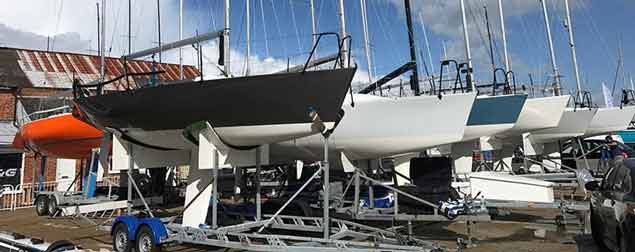 Ready for racing - the 23–boat fleet lined up in Cowes Yacht Haven included on Irish entry, Anchor Challenge from Cork
Ready for racing - the 23–boat fleet lined up in Cowes Yacht Haven included on Irish entry, Anchor Challenge from Cork
Aguila has been the form Quarter–Tonner this year and has won most of this year's events. They have tried a number of times to win this event, but failed in the past at the final hurdle, often to Louise Morton's Bullit. This year they left no stone unturned and prepared the Boat immaculately and spent up to ten weekends practicing and competing in Quarter Ton class events in Cowes in preparation for the Quarter Ton Cup. They were worthy winners and took all three races on the final day to win easily in the end. They did, however, have a disqualification due to a protest Lodged by Anchor Challenge for an on–the–water incident on day one and so had to be very careful not to have a bad race or an OCS as they had already used their discard.
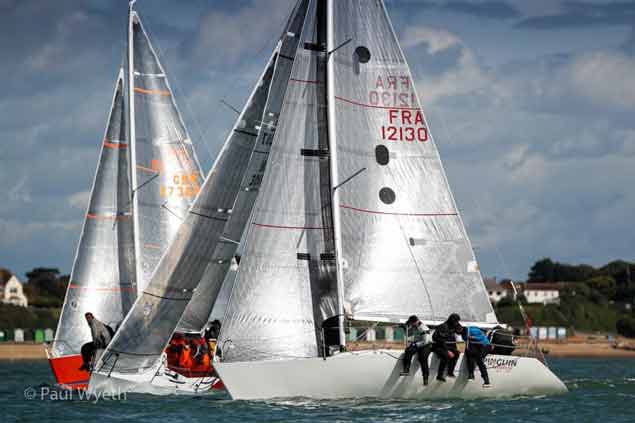 Close racing at the Cup Photo: Paul Wyeth
Close racing at the Cup Photo: Paul Wyeth
The first day of racing was cancelled so four races were scheduled and completed on day two in brisk 20 to 25 knot winds that witnessed some spectacular broaches. Two race wins from Ian Southworth's Whiskers took him to the top of the leaderboard, just ahead of the Paul Lees steered Black Fun, with the Mark Richmond steered Cote next and Anchor Challenge, with one race win, in fourth Place. Sam Laidlaw had dropped to fifth overall but counted a DSQ, which he would be looking to discard.
Day two had very different condition with a light seven knot breeze out of the Northwest. Four races were scheduled but this would always be an ask as the final race had to start by 14.30. Sam Laidlaw made no mistakes and from the off was the one to beat, finding very good speed in these lighter conditions. Ian Southworth tried to stay in contention and was only two points back going into the third race of the day. A tenth in that race scuppered his chances and with the wind dying and the 14.30 timelimit approaching the OOD, Rob Lamb, signaled an end to the Day and the Regatta. Paul Lees, 2nd going into the day overall had a 16th and a 14th to drop him to fifth overall. Cote had solid results as did Anchor Challenge.
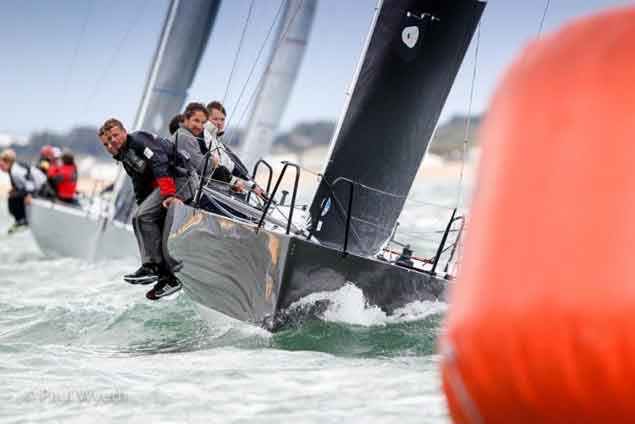 Mark Richmond's Cote approaching the windward mark on day two of the Coutts Quarter Ton Cup 2017 with Land Rover BAR sailor Nick Hutton on board as bowman Photo: Paul Wyeth
Mark Richmond's Cote approaching the windward mark on day two of the Coutts Quarter Ton Cup 2017 with Land Rover BAR sailor Nick Hutton on board as bowman Photo: Paul Wyeth
Anchor Challenge could possibly have taken a third overall as she had to divert behind a ship coming in the North Channel in race six which took her from third to tenth in that race and in the end she missed out on the podium by three points. She had very good speed in the breeze and was solid in the light and was definitely one of the fastest boats in the fleet. However the level of time put in by San Laidlaw seems to have taken him up a notch and he was the deserving winner this year.
Going into the event, other favourites were class President, Louise Morton's Bullit which had won the three previous Quarter Ton Cups, but unfortunately Louise did not find any form this year and had to contend with 10th overall, three places ahead of her husband Peter Morton on Innuendo who finished in 13th Position. Peter is the current Fast 40 One Ton Cup Champion on Girls on Film.
Boat Changes
3 newly updated Quarter tonners were in evidence this year, Oliver Orphaus has a beautifully prepared job done On Bullet, a Near Sistership to Buttit. Oliver finished in 9th Position. Tom Hill had John Corby prepare his Belinda and she was looking immaculate and clearly was one that everyone wanted to see do well. The stronger winds on Thursday were not to his liking but the boat performed very well in the lighter conditions to finish in 12th overall. Finally Barry Arts from Holland had the Beautiful Stephen Jones Designed Wings in immaculate condition, however he could not find much speed and finished down the fleet.
 Tom Hill's John Corby prepared Belinda Photo: Mark Mansfield
Tom Hill's John Corby prepared Belinda Photo: Mark Mansfield
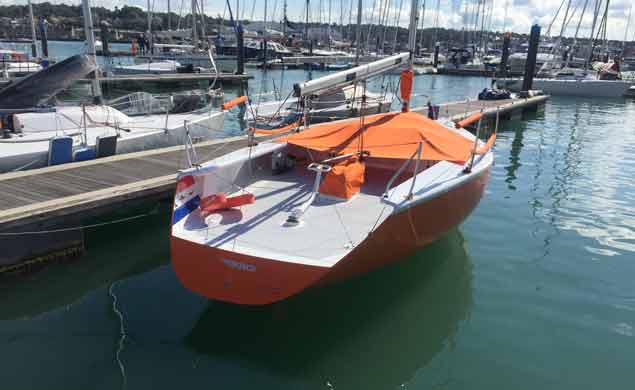 Barry Arts from Holland brought the Beautiful Stephen Jones Designed Wings to Cowes Photo: Mark Mansfield
Barry Arts from Holland brought the Beautiful Stephen Jones Designed Wings to Cowes Photo: Mark Mansfield
Competition
Clearly the event is going from strength to strength with 23 entries and nearly all of these are now fully restored with new rigs and new keels. Of the 23 competitors, 16 had at least one professional and some had up to four pros on board. The class has an owner driver rule with no limit on professionals. Some eyebrows were raised when a driver in the fleet was allowed to compete who was not an owner and in the past such applications had been declined. Going forward the class will need to keep an eye on the way this rule is observed if it wants to attract owner–drivers.
So how do Quarter Tons compare to Half Tons?
Having finished fourth in this year's Half Ton Cup with Michael and Richard Evans, The Big Picture, it is easy to see that the Quarter Ton class is still more competitive than the Half Ton class, but not by much, and the gap is closing. The Quarter Ton class favours no limit on professionals whereas the Half Ton class is likely going to set a limit on professionals.
I would say there are likely more Quarter Tonners that can win races whereas in the Half Ton Class, it is only about six at the moment at the top level. The Quarter Tonners behave more like a dinghy whereas the Half Tonners are more cruiser like. This can be seen downwind where the top Quarter Tonners will reach much higher speeds in a breeze than the Half Tonners.
Much of this is due to the weight of the boat with the Halfs having inboard diesel engines, whereas the Quarters only have small outboards. The rigs would be set up similarly in each case, though most Quarter–Tonners have just one set of spreaders, whereas the Half–Tonners have two sets of spreaders, requiring a bit more care in the set up.
The sails are quite similar except that the Quarter Ton rigs are much more flexible and so the rigs on these need to be adjusted all the time. Extra turns on the forestay and upper and lower shrouds in the breeze to straighten the forestay while still allowing a decent amount of backstay to be used before the mainsail runs out of luff round and no further backstay can be used.
 Tuning and calibration on the White family's Joker
Tuning and calibration on the White family's Joker
The Half Tonners, with their stiffer masts allow a lot of backstay use and rarely run out of luff–round.
Next year, The Quarter Ton Cup will return to its normal June slot and up to four events are planned in advance of this June event, to allow competitors to prepare for the event. Clearly Sam Laidlaw has set a marker on what level of time and preparation is needed if you want to win the Quarter Ton Cup.
Mark Mansfield is a four time Olympian in the Star Class and a Racing Consultant with UK Sailmakers Ireland
Royal Cork's Anchor Challenge Racing at Quarter Ton Cup, Day One Blown Out
Strong winds prevent play on opening day of Coutts Quarter Ton Cup 2017. 23–boats are entered for the event with a single Irish boat in the line up of exquisitely prepared classic race boats – along with some of the world's best sailors – have gathered in Cowes for the 13th edition of the Cup.
Paul Gibbons and the Anchor Challenge crew (including four–time Olympian Mark Mansfield onboard ) from Royal Cork Yacht Club are in the high–end fleet with competitors drawn from four countries.
As regular Afloat.ie readers will recall ICRA Champ Gibbons was in warm up mode late last month at his Cork club's At-Home regatta taking the top prize in Crosshaven. The RCYC sailor is also an inaugural IRC Euro champ, earning that honour at Cork Week 2016.
As ever, there's a diverse variety of sailors, ranging from members of Ben Ainslie's 2017 Land Rover BAR America's Cup team, through seasoned trans-Atlantic solo racers, to long-standing Solent gurus. However, parachuting in a team of hot-shot experts is no guarantee of winning this event - it's often the crews that have practiced and raced together over a longer period that have the consistency to come out on top.
Cork Harbour sailors has won the revived 'Corinthian' division of the Cup three times since 2005. Royal Cork's George Kenefick won it twice in 2011 and 2012 (and earned him Afloat Sailor of the Year award) and in 2014 Cork Harbour's Illes Pitiuses sailed by Dominic and Jason Losty were also winners.
The opening day dawned with blue skies and a brisk 20-25 knot westerly breeze. However, with the wind forecast to increase during the morning, the fleet was held ashore while two mark laying RIBs ventured out at 1100 to check on conditions first hand, which led to a decision to abandon racing for the day.
"We've been out on the Hill Head Plateau, where there's 22-25 knots of wind, with a sharp Solent chop and broken water," explained Principal Race Officer, Robert Lamb of the Royal Southampton YC, "...and there's no prospect of the wind dropping before the tide turns to the west later this afternoon, when the wind against tide will kick up an even worse sea state."
With the two Quarter Tonners that broke rigs during this year's Cowes Week serving as a fresh reminder of the relatively fragile nature of these boats, there was overwhelming support for the decision from owners and sailors. "I think everyone will be pleased, especially at this stage of the regatta, where you don't want to risk damage," said Tom Hill, owner of the newly restored Belinda.
Hill is a long-standing Quarter Ton owner, having sailed Runaway Bus for several years, before buying and refitting Belinda. "The standard is very high in the fleet," Hill says, "so you have to keep improving and you learn a lot by sailing against the strongest teams. Belinda is a fairer shape than Runaway Bus and is a much better boat in stronger breezes. John [Corby] did a fantastic job - the boat is now very rigid and feels really solid in a way that's lacking in some older boats."
Tomorrow the forecast is for a west-north-westerly breeze averaging 15 knots, but with significantly strong gusts. The intention is to complete four 45-minute races, with the first warning signal for the 23-strong fleet at 1100.
Final Call For ICRA National Championships: Reduced Entry Fee Discount Closes on Friday
The ICRA Cruiser National Championships reduced entry fee registration of €150.00 will end this Friday 12th May, just a month before the event sets sail at Royal Cork Yacht Club from 9th – 11th June. The final closing date for entry is the 26th May. Enter online here.
As of today, ICRA estimates over sixty percent of the expected boats have entered the championships. 'Thanks to all the boats that have entered so far as this assists greatly with the planning of the event', ICRA Commodore Simon McGibney told Afloat.ie
The J24 Association of Ireland will be hosting their Southern Championships during the event and the Quarter tonner will in addition to be racing in division but also will be racing for the Quarter Ton Cup.
Royal Cork Yacht Club's Anchor Challenge counted a tenth and two fifth places after the first day of the Coutts Quarter Ton Cup in Cowes to be sixth overall in the 26–boat fleet yesterday. The Paul Gibbons skippered Farr–type design leads Irish hopes. Ben Daly's Cobh Pirate is 13th. The recently crowned ICRA three class champion Ken Lawless, sailing Cartoon, a Jacques Faroux type, had what crew are describing as a 'bruiser' of a day. The Royal Irish Yacht Club yacht did not finish the last race and lies 24th.
Bruiser of a day today, the fleet took a hiding! #CartoonFR9186 #riyc @hlmarine @AfloatMagazine #banjaxed pic.twitter.com/A2bOaSPGNo
— Shane Cronin (@ShaneMCronin) June 15, 2016
Louise Morton’s Bullit is leading the fleet by four points from Sam Laidlaw’s Aquila with Ian Southworth and the Whiskers team in third and Willie Mcneill’s Immigrant a close fourth.
In the Corinthian Division it’s Frenchman Pierre Paris and the Pinguin Playboy crew who lead from George Webb’s Flashheart with Rob McLean in Spider Pig third, while the new Low Rating Division for the Roger Swinney Trophy is led by Piers Hugh Smith helming Magnum Evolution with Flashheart second and Spider Pig third.
The Royal Yacht Squadron based event on the Western Solent runs until Friday with three more races scheduled today.
Provisional results after three races below
The series opened in spectacular style off Cowes with three windward leeward races in the Central Solent in a building south westerly which produced fast paced action and more than a few classic Quarter Ton spills. The twenty-six strong fleet gave no quarter and it was nip and tuck at every mark rounding with place changes galore on each leg. Racing got underway in around 17 knots but it wasn't long before the breeze was up to 20 knots with gusts of 25 knots, making for tough sailing for the notoriously tender historic little Quarter Tonners.
Race Officer Rob Lamb and his Royal Yacht Squadron Racing team did a superb job with the windward leeward courses, and the sailors took full advantage as event sponsor Coutts and their guests enjoyed ringside seats aboard the classic motor yacht Rum Jungle.
Fortunately, the odd pirouette didn't prevent some great performances on the water and reigning Coutts Quarter Ton Cup Champion Louise Morton and her all girl team aboard Bullit revelled in the tricky conditions to win races one and three and take second in race two. They now lead the regatta overall by four points from Sam Laidlaw's Rolf Vrolick designed Aquila with Ian Southworth's Joubert Nivelt designed Whiskers two and a half points back in third and Willie McNeill's Ceccarelli designed Illegal another half a point behind in fourth.
Back ashore the Whiskers crew of Ian Southworth, Tris Nelson, Mike Stannard, John Santy and Led Pritchard seemed slightly bemused to find themselves up in the chocolates having made their usual last minute dash to the regatta. "We're just having a laugh and keeping it simple. We managed to keep the boat on her feet all day, but the same couldn't be said of the crew. At one point we had a bit of a dead ants situation with all us in a heap in the cockpit with our legs in the air and Stan on the bottom trying to figure out why it had gone dark and what the heck had happened to the winch handle." Joked John Santy.
Although there were a number of dramatic moments during today's racing, one of the most marked things about the Quarter Ton fleet is the exceptional quality of the sailors and their outstanding seamanship. Despite the numerous broaches nobody went over the side, although Tony Harrison aboard Per Elisa did come close, just managing to hang onto the grab-rail and drag himself back aboard when he found that the high side had become the semi submerged side unexpectedly. Per Elisa's tactician Graham Bailey explained saying, "Every now and then they spin out and you don't get much notice. It was a drop where we had to take the pole off before the drop and the spinnaker momentarily collapsed and then pulled out to one side and we lost control of it. These things can escalate catastrophically so we were lucky Tony stayed with the boat. Our boat was built as a lake boat, but we just manage to hang onto the lead bunch today. Conditions to an extent determine which boats can do well, so we're hoping for some lighter winds for the remaining races."
At the apres sailing fleet BBQ, hosted by Class Chairman Peter Morton at Cowes Yacht Haven, there was much discussion about who had done the most broaches. Peter finally resolved the matter by asking all the skippers to stand up. He then asked those who had not broached all day to sit down, then those who had only broached once to sit down, then twice, then three times. With three skippers still standing Peter asked those who had broached four times to sit down, which left just 2007 Etchells World Champion Oscar Strugstad of the Laurie Davidson designed Blackfun standing, which only goes to prove that even the best in the world can find a Quarter Tonner hard to handle in big breeze! Fortunately all that rocking and rolling didn't seem to hold them back too much and they clocked up a second, eighth and seventh to put them into fifth place overall.
Sailing with Oscar on Blackfun this week is his Etchells World Championship winning crew Simon Fry. Sailing with Rickard Melander aboard the Phil Morrison designed Alice II is Andy Beadsworth, who was Oscar and Simon's third crew member at that Etchells Worlds. Clearly Andy was missing his team mates today and decided to visit them when Alice II broached and found herself "kissing" Blackfun. Alice II was on port so took a penalty and John Corby put in some late night overtime to fix the hole in Blackfun so she will be back out on the water today.
Welcomed to the revival Quarter Ton fleet for the first time today was Diarmid de Burgh-Milne, whose recently purchased Lacydon Protis, winner of the 1981 Quarter Ton Cup, has just come out of a major refit at Casse Tete. Today was the first time Diarmid and his crew had actually sailed the boat and the first order of the day was to get the new sails out of their boxes and hope they fitted. Fortunately they did and Daiarmid reported that they enjoyed a fantastic day on the water, albeit one with a very steep learning curve!
Another boat making her first appearance at a Coutts Quarter Ton Cup revival is the Laurie Davidson designed Hellaby, now owned by Robbie Stewart. Her addition to the fleet means that today we had the the entire podium from the 1980 Quarter Ton Cup racing together for the first time in 36 years - Lousie Morton's Bullit which won the 1980 event, runner up Hellaby and third placed Anchor Challenge, now owned by Paul Gibbons.
The Corinthian Division, for all amateur crews, is led after day one by the French team of Pierre Paris aboard the Tony Castro designed Pinguin Playboy, which crossed the channel on her own bottom to be here this week and won all three Corinthian races today. Lying five points behind her in second is George Webb's Ed Dubois designed Flashheart who made a poor early sail choice as crewmember Geoff Dakin explains; "Early on we went with the big masthead kite, but we were all over the show wiping out left right and centre, so we swopped to the fractional kite and were much happier." Third place in the Corinthian Division after day one is held by Rob McLean's Spider Pig, which was designed by Olivier Gilbert and is tonight just one point behind Flashheart.
Introduced in 2015, the Low Rating Division, for which the Roger Swinney Trophy will be presented, allows the older and smaller boats a chance to shine and after three races it is led by Piers Hugh Smith racing the Julian Everitt designed Magnum Evolution with Flashheart in second and Spider Pig third.
The forecast for day two of the regatta is for much lighter winds which will bring welcome respite for many. The regatta continues until Friday 17 June with up to nine races scheduled.
Cobh Pirate Makes Quarter Ton Debut in Cowes
After the high winds disappointment of day one, day two of the Coutts Quarter Ton Cup produced four wonderful races in perfect Solent conditions. The day had opened with light airs and it took a three hour postponement before the sea breeze finally kicked in, but once it arrived the race committee took full advantage of it to run races one to four of the nine race series. From the off the fleet was in spectacular form with closely packed starts, frantic mark roundings and constant place changes on every leg. There were no less than three dead heats on corrected time and multiple photo finishes on the water.
In the overall standings Louise Morton and her team sailing the 1979 Fauroux designed Bullit have dominated the results, ably demonstrating that their reputation as one of the smartest and most practised teams in the fleet is well deserved. With two wins, a second and third place she leads the fleet overnight by a ten point margin from nearest rival Aguila, owned by Sam Laidlaw, with Eric Reynolds' Magnum Evolution four further points behind in third. Magnum Evolution also heads the Low Rating Division, for boats with an IRC rating of 0.899 or below, while the Corinthian Division for all amateur crews is led by the French team of Pierre Paris's Pinguin Playboy.
From the off Louise Morton and Bullit meant business. At the first weather mark of the regatta they came in on starboard neck and neck with Richard Fleck's Per Elisa, who approached on port. Per Elisa attempted to tack in in front of Bullit but hit the mark and was forced to spin out and do turns. Per Elisa's crew are so well drilled that they completed their turns quick smart and still rounded the spreader mark in second place. Behind them Rickard Melander's Alice II rounded well down in the pack, but was determined not to stay there and soon began moving their way through the fleet. On the line Bullit took the chequered flag with Alice II second, Per Elisa third and Sam Laidlaw's Aguila fourth.
After a lacklustre twelfth place in race one Tony Hayward's Blackfun found her feet in race two to lead the fleet from start to finish. Bullit chased her all the way around the track but on the line it was Blackfun's race by a mere eight seconds from Bullit with Alice II seven seconds back in third and Aguila fourth.
Blackfun shone again in race three winning by a margin of 21 seconds from Magnum Evolution with Bullit third and Coutt's Quarter Ton Cup newcomer Rob Mclean sailing Spider Pig fourth.
Blackfun's form didn't hold for the fourth race though and she finished in eighth, while Bullit claimed her second victory by a mere three seconds from Aguila with Per Elisa third. Fourth place was a corrected time dead heat between Magnum Evolution and Alice II.
The racing throughout the fleet has been fabulous to watch. The boats are so evenly matched that even second weather mark rounding are still full of drama and excitement for the spectators. Revival Quarter Ton Class founder Peter Morton, who has won the regatta no less than four times in three different boats, finds himself struggling for traction this year. Sailing the 1989 Fauroux designed Tiger, winner of the Corinthian Coutts Quarter Ton Cup in 2011 and 2012, Peter was never out of the top ten, but his 5, 7, 8, 9 scoreline puts him down in fifth place overall.
But the racing is only part of the story of the Quarter Ton Class, the boats themselves are the stars of the show and they hold a special place in the hearts of their owners. Even when they change hands there are often touching stories that bind each boat's owners together. Making their first appearance at a Coutts Quarter Ton Cup this year are Mike and Ben Daly sailing Cobh Pirate, which was purchased from Dominic and Jason Losty earlier this year. Under Dominic and Jason's ownership the boat was known as Illes Pitiuses, but although they were delighted to sell the boat to Mike and Ben they wanted to retain the name. And so the hunt for a new name was on. Dominic and Jason are both well known Irish Rugby players and it just so happens that Mike Daly's father, Jack Daly, was an Irish International ruby player and grand slam winner who played for Cobh Pirates Rugby Club, the same club that Dominic and Jason played for, so Cobh Pirates it is.
The Coutts Quarter Ton Cup is famous for its "special" prizes and today's bottle of Rum Jungle Rum goes without doubt to Rob Mclean's Spider Pig. They are also Quarter Ton Cup newcomers and were on a rapid learning curve. They opened with a 17th in race one, moved up to 11th in race two and then really hit their form with a fourth in race three. Sadly their run of lack came to an end in race four when they lost their rig and were forced to retire. Tonight every effort is being made to get them back on the water tomorrow.
Tomorrow's final day will be a busy one for the fleet. Five races remain to be sailed although in reality a first start time of 11.00 and a final start time cut off of 14.30 unless there is a general recall or postponement during the starting sequence make that a hard goal to achieve. The forecast is indicating south easterly winds of 10 to 18 knots so hopes are high of an onetime start and race officer Rob Lamb has confirmed that he will run as many of the remaining races as time permits. The single discard will be introduced once six races have been sailed.




























